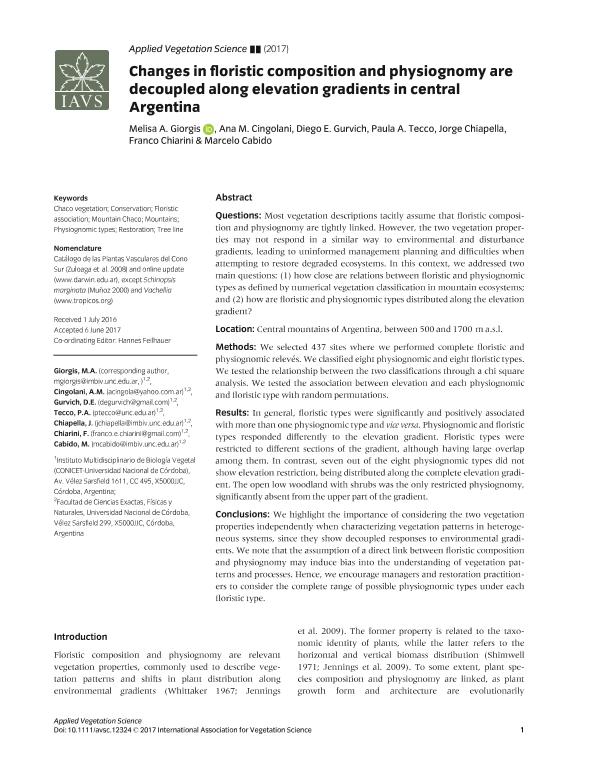Mostrar el registro sencillo del ítem
dc.contributor.author
Giorgis, Melisa Adriana

dc.contributor.author
Cingolani, Ana María

dc.contributor.author
Gurvich, Diego Ezequiel

dc.contributor.author
Tecco, Paula Andrea

dc.contributor.author
Chiapella, Jorge Oscar

dc.contributor.author
Chiarini, Franco Ezequiel

dc.contributor.author
Cabido, Marcelo Ruben

dc.date.available
2018-10-11T14:28:46Z
dc.date.issued
2017-10
dc.identifier.citation
Giorgis, Melisa Adriana; Cingolani, Ana María; Gurvich, Diego Ezequiel; Tecco, Paula Andrea; Chiapella, Jorge Oscar; et al.; Changes in floristic composition and physiognomy are decoupled along elevation gradients in central Argentina; Wiley Blackwell Publishing, Inc; Applied Vegetation Science; 20; 4; 10-2017; 558-571
dc.identifier.issn
1402-2001
dc.identifier.uri
http://hdl.handle.net/11336/62174
dc.description.abstract
Questions: Most vegetation descriptions tacitly assume that floristic composition and physiognomy are tightly linked. However, the two vegetation properties may not respond in a similar way to environmental and disturbance gradients, leading to uninformed management planning and difficulties when attempting to restore degraded ecosystems. In this context, we addressed two main questions: (1) how close are relations between floristic and physiognomic types as defined by numerical vegetation classification in mountain ecosystems; and (2) how are floristic and physiognomic types distributed along the elevation gradient?. Location: Central mountains of Argentina, between 500 and 1700 m a.s.l. Methods: We selected 437 sites where we performed complete floristic and physiognomic relevés. We classified eight physiognomic and eight floristic types. We tested the relationship between the two classifications through a chi square analysis. We tested the association between elevation and each physiognomic and floristic type with random permutations. Results: In general, floristic types were significantly and positively associated with more than one physiognomic type and vice versa. Physiognomic and floristic types responded differently to the elevation gradient. Floristic types were restricted to different sections of the gradient, although having large overlap among them. In contrast, seven out of the eight physiognomic types did not show elevation restriction, being distributed along the complete elevation gradient. The open low woodland with shrubs was the only restricted physiognomy, significantly absent from the upper part of the gradient. Conclusions: We highlight the importance of considering the two vegetation properties independently when characterizing vegetation patterns in heterogeneous systems, since they show decoupled responses to environmental gradients. We note that the assumption of a direct link between floristic composition and physiognomy may induce bias into the understanding of vegetation patterns and processes. Hence, we encourage managers and restoration practitioners to consider the complete range of possible physiognomic types under each floristic type.
dc.format
application/pdf
dc.language.iso
eng
dc.publisher
Wiley Blackwell Publishing, Inc

dc.rights
info:eu-repo/semantics/openAccess
dc.rights.uri
https://creativecommons.org/licenses/by-nc-sa/2.5/ar/
dc.subject
Chaco Vegetation
dc.subject
Conservation
dc.subject
Floristic Association
dc.subject
Mountain Chaco
dc.subject
Mountains
dc.subject
Physiognomic Types
dc.subject
Restoration
dc.subject
Tree Line
dc.subject.classification
Otras Ciencias Biológicas

dc.subject.classification
Ciencias Biológicas

dc.subject.classification
CIENCIAS NATURALES Y EXACTAS

dc.title
Changes in floristic composition and physiognomy are decoupled along elevation gradients in central Argentina
dc.type
info:eu-repo/semantics/article
dc.type
info:ar-repo/semantics/artículo
dc.type
info:eu-repo/semantics/publishedVersion
dc.date.updated
2018-10-09T18:55:11Z
dc.journal.volume
20
dc.journal.number
4
dc.journal.pagination
558-571
dc.journal.pais
Reino Unido

dc.journal.ciudad
Londres
dc.description.fil
Fil: Giorgis, Melisa Adriana. Consejo Nacional de Investigaciones Científicas y Técnicas. Centro Científico Tecnológico Conicet - Córdoba. Instituto Multidisciplinario de Biología Vegetal. Universidad Nacional de Córdoba. Facultad de Ciencias Exactas Físicas y Naturales. Instituto Multidisciplinario de Biología Vegetal; Argentina
dc.description.fil
Fil: Cingolani, Ana María. Consejo Nacional de Investigaciones Científicas y Técnicas. Centro Científico Tecnológico Conicet - Córdoba. Instituto Multidisciplinario de Biología Vegetal. Universidad Nacional de Córdoba. Facultad de Ciencias Exactas Físicas y Naturales. Instituto Multidisciplinario de Biología Vegetal; Argentina
dc.description.fil
Fil: Gurvich, Diego Ezequiel. Consejo Nacional de Investigaciones Científicas y Técnicas. Centro Científico Tecnológico Conicet - Córdoba. Instituto Multidisciplinario de Biología Vegetal. Universidad Nacional de Córdoba. Facultad de Ciencias Exactas Físicas y Naturales. Instituto Multidisciplinario de Biología Vegetal; Argentina
dc.description.fil
Fil: Tecco, Paula Andrea. Consejo Nacional de Investigaciones Científicas y Técnicas. Centro Científico Tecnológico Conicet - Córdoba. Instituto Multidisciplinario de Biología Vegetal. Universidad Nacional de Córdoba. Facultad de Ciencias Exactas Físicas y Naturales. Instituto Multidisciplinario de Biología Vegetal; Argentina
dc.description.fil
Fil: Chiapella, Jorge Oscar. Consejo Nacional de Investigaciones Científicas y Técnicas. Centro Científico Tecnológico Conicet - Córdoba. Instituto Multidisciplinario de Biología Vegetal. Universidad Nacional de Córdoba. Facultad de Ciencias Exactas Físicas y Naturales. Instituto Multidisciplinario de Biología Vegetal; Argentina
dc.description.fil
Fil: Chiarini, Franco Ezequiel. Consejo Nacional de Investigaciones Científicas y Técnicas. Centro Científico Tecnológico Conicet - Córdoba. Instituto Multidisciplinario de Biología Vegetal. Universidad Nacional de Córdoba. Facultad de Ciencias Exactas Físicas y Naturales. Instituto Multidisciplinario de Biología Vegetal; Argentina
dc.description.fil
Fil: Cabido, Marcelo Ruben. Consejo Nacional de Investigaciones Científicas y Técnicas. Centro Científico Tecnológico Conicet - Córdoba. Instituto Multidisciplinario de Biología Vegetal. Universidad Nacional de Córdoba. Facultad de Ciencias Exactas Físicas y Naturales. Instituto Multidisciplinario de Biología Vegetal; Argentina
dc.journal.title
Applied Vegetation Science

dc.relation.alternativeid
info:eu-repo/semantics/altIdentifier/doi/https://dx.doi.org/10.1111/avsc.12324
dc.relation.alternativeid
info:eu-repo/semantics/altIdentifier/url/https://onlinelibrary.wiley.com/doi/full/10.1111/avsc.12324
Archivos asociados
